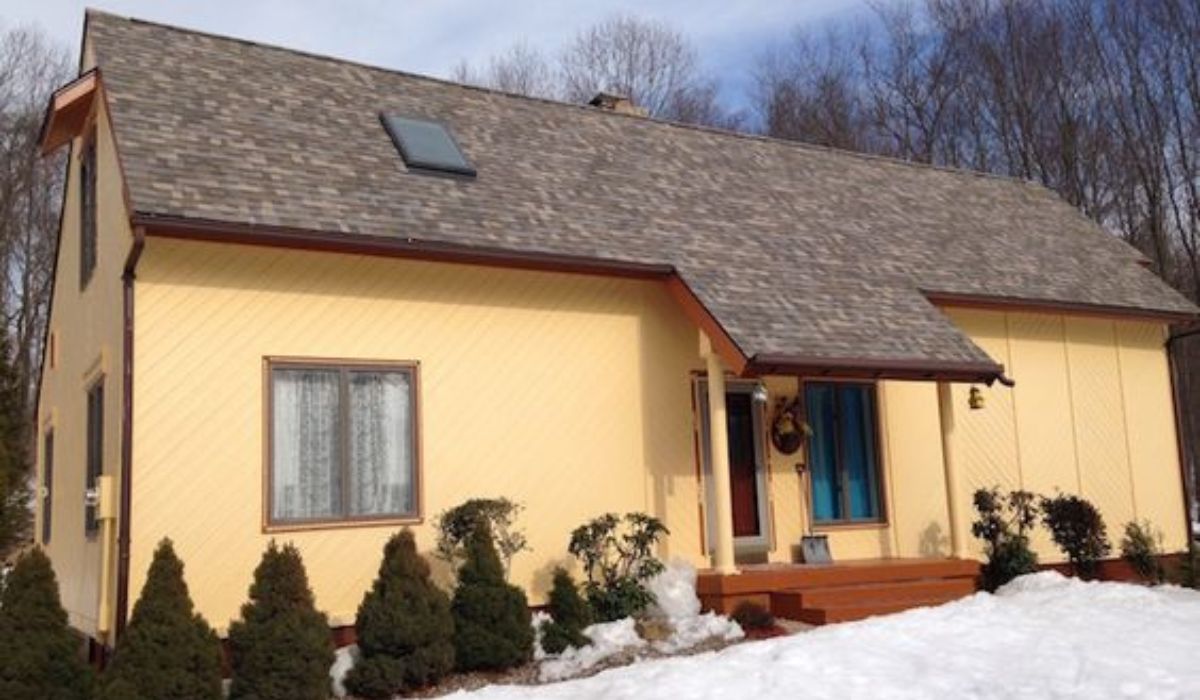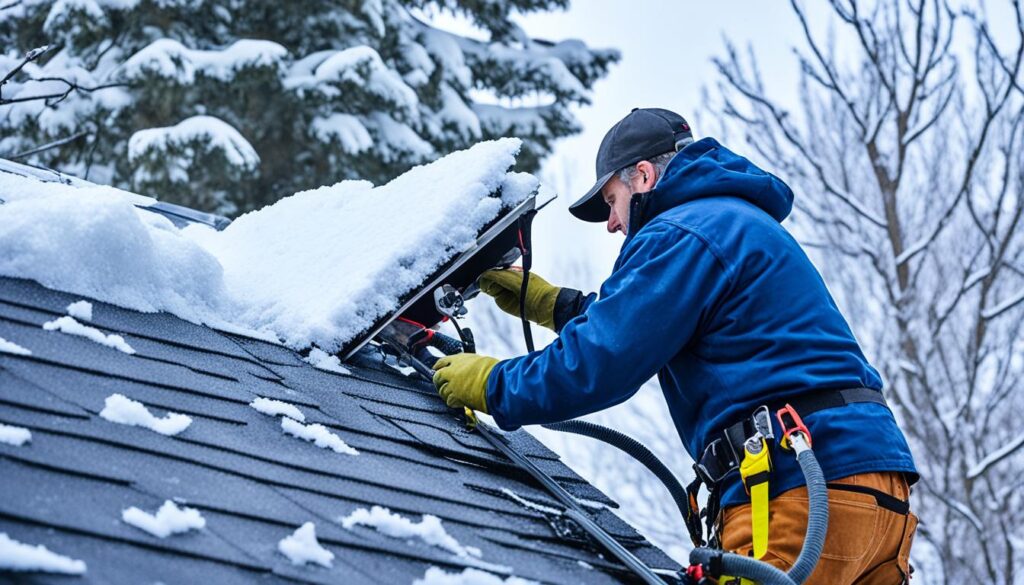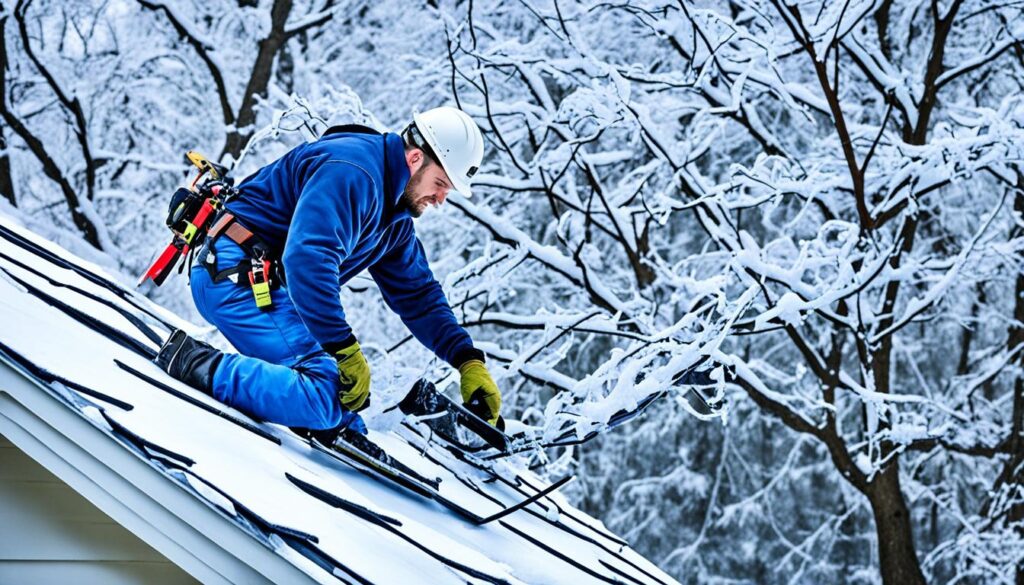
As winter arrives, homeowners often ask if they can fix their roof. The cold and unpredictable weather makes people doubt if roofing is possible in winter. They wonder if they can do it safely and effectively.
This article will look into winter roofing. We will discuss its challenges, risks, and benefits. If you’re thinking about roof work, it’s crucial to know what’s involved. We aim to help both homeowners and roofers understand winter roofing better.
Key Takeaways:
- Roofing in the winter is possible with the right precautions and a reputable contractor.
- Understanding the challenges and risks associated with winter roofing is crucial.
- Winter roof installations have advantages, such as timely repairs and potential cost savings.
- Proper temperature conditions and handling of roofing materials are essential during winter roof installation.
- Safety and quality should be prioritized when undertaking winter roof replacement.
Understanding the Challenges of Roofing in Winter
Roofing in winter brings its own set of problems. Rain, snow, and ice make roofs slippery. This can be dangerous for workers. They need to be extra careful and know about these wintertime dangers.
Staying safe is a big issue. Workers must use safety gear to prevent falls. They also should pick days with no rain or snow. This way, they can work safer and get more done.
[“Roofing during winter months can be challenging due to the slippery conditions caused by rain, snow, and ice.”]
Cold weather affects tools like nail guns. Nail guns might not work right. This can make the roof less strong and let leaks happen.
[“Cold temperatures can affect the performance of nail guns, which can lead to improper nail placement during winter roof installation.”]
Shingles also face issues in the cold. They become brittle and can crack. It’s important to be very gentle with shingles when putting them on. This helps the roof last a long time.
[“Shingles can become brittle and prone to cracking in colder temperatures, requiring extra care during installation.”]
Metal and slate roofs handle winter well. They work better in the cold and protect homes from severe weather. They are a good choice for winter projects.
To do a good job in winter, roofers must know how to deal with ice, nail guns, and shingles. These challenges are key to a roof that lasts for years.
Winter roof replacement has its good and bad points. Homeowners should think about these before starting. Knowing the good and bad points can help make a smart choice and lead to a good result.
Advantages of Winter Roof Replacement
Replacing your roof in winter means you’re ready for the heavy spring rains. Fixing any problems now can stop leaks and damage later.
Winter is a less busy time for roofers, so you might get your work done faster. This is good news if you need repairs soon or if you’re selling your home.
Your plants and outdoor stuff are usually put away in winter. This means they aren’t at risk of getting damaged during the roofing work.
Winter installations might be cheaper because some contractors offer specials. Saving money is always a plus for homeowners.
Risks and Challenges
But there are dangers, too. Working on a roof covered in snow and ice is risky. Contractors must be very careful to avoid accidents.
The cold might make some roofing materials harder to work with. This could mean lower quality work or issues later on.
Roofing warranties might not cover work done in the cold. This could leave you without protection for material or work issues.
That’s why picking the right contractor is so important. They should be skilled in winter work and know how to avoid these problems. This ensures a job well done.
The Temperature Requirements for Winter Roof Installation
Shingle technology advances have changed how we think about winter roof jobs. Now, shingles can be installed in colder weather. They prevent shingle cracking better. But, it’s still important to warm up the shingles before putting them on your roof. This step helps avoid breakage.
Now, materials like metal and slate are great for cold-weather roofs. They aren’t as bothered by the chill. This makes them strong and steady choices for winter.
Getting the temperature right and handling shingles carefully are key for a good roof in winter. Following these steps helps both homeowners and roofers. It avoids problems and leads to a solid roof.

Ensuring Safety and Quality During Winter Roof Replacement
For winter roof replacements, extra safety steps are a must. They keep the team safe and the job well done. Workers’ safety is key. This means they wear fall protection equipment and use safer tools like snips. During the winter, roofing needs a extra careful touch.
Exercising Good Judgment in Challenging Weather Conditions
Starting a winter roof replacement means watching the weather closely. The team checks the temperature, wind, and if it might rain or snow. Safety always comes first. If it’s too risky, they wait for better weather.
Hiring a top-notch roofing contractor for your winter roof installation is key. Their skilled team knows the ropes for winter roofing. Good contractors make sure the roof can handle tough winter conditions.
Following Proper Procedures for a Sturdy Roof
Doing things right is crucial for a high-quality winter roof replacement. Skilled contractors know the best ways to install roofs in the cold. They make sure the roof is well-insulated and sealed against ice and snow.
In winter, focusing on safety and quality is vital for a successful project. With the right safety steps, weather checks, and skilled contractors, the roof will be strong. Homeowners can trust their roof will weather the winter well.

Understanding the Risks of Winter Roof Installation
Winter roof installation comes with its own set of challenges. The cold weather and icy roofs make work unsafe, so safety is key. Also, cold temperatures change how materials and tools work, which can cause problems with the roof.
Installing a roof in winter means the warranty might not cover everything. Cold weather could make products fail, affecting your warranty. It’s important to look at the warranty details before you start.
Winter installations might take longer, and bad weather can delay things even more. This means your home is open to the weather longer, which could lead to costly damage inside.
Choosing the right roofer is crucial to dealing with these risks. A professional will understand how to work in cold weather, ensuring safety and quality. They’ll protect their team and make sure your roof is installed properly.

Despite the challenges, installing a roof in winter can be done with care. Homeowners should be aware of the risks and plan wisely. Safety, checking the warranty, and finding a skilled roofer are vital for a successful winter project.
Conclusion
Installing a roof in winter is manageable with proper care. It’s important to assess the risks first. Working with a known winter roof expert is key for a good outcome.
Roofing in winter brings its own issues, like ice and cold. But, it’s a chance for quick roof fixes before spring. Plus, you might find good deals on the work.
Choosing who does your winter roof job is vital. Look for someone who knows winter work well. They can make sure things are done right, offering your home great protection.

Meet William Adams, a seasoned roofing expert with over 30 years of hands-on experience in the industry. Having worked tirelessly under the scorching sun and through the fiercest storms, William brings a wealth of knowledge and expertise to the table. Hailing from the heart of the USA, he’s witnessed the evolution of roofing practices firsthand, mastering every aspect along the way. Now retired from the field, William spends his days cherishing time with his loved ones while sharing his invaluable insights through this platform. With William at the helm, you can trust that every tip, advice, and recommendation provided is backed by years of real-world experience and unwavering dedication to quality craftsmanship. Join us as we journey through the world of roofing, guided by the wisdom and passion of a true industry veteran.
